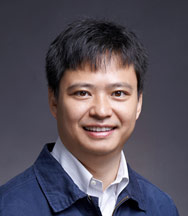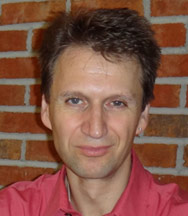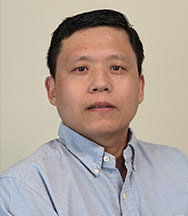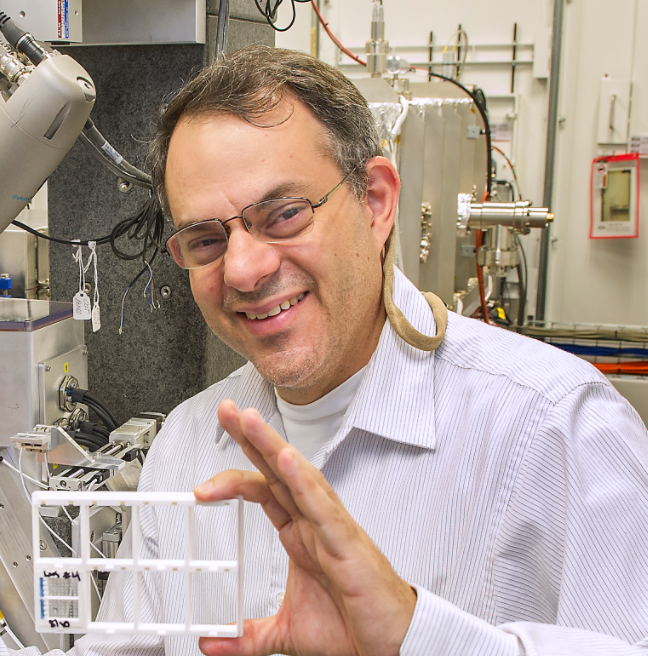SEED Grants Awarded 2021
DeepCryo: Heterogeneous Cryogenic Electron Microscopy Analysis using Deep Learning
|
Haibin Ling Qun Liu |
 Haibin Ling |
 Qun Liu |
Abstract:
Cryogenic electron microscopy (cryo-EM) is a powerful technique for inferring the structures of biological molecules at near-atomic resolution. It waives the expensive procedure of crystallization and can capture molecules in their native states. A key step in cryo-EM analysis is to reconstruct 3D molecule structures from a huge amount of noisy 2D projection images extracted from multiple micrographs. Current solutions typically follow the Bayesian reconstruction pipeline with major components extended from traditional computer vision techniques. Despite great progresses achieved, 3D molecule structure reconstruction from cryo-EM images remains challenging due to the extremely noisy input and the structure complexity. Moreover, existing solutions focus mainly on homogeneous reconstruction, leaving the rich conformation information under-explored.
Addressing these challenges, the interdisciplinary team plans to develop a novel reliable and efficient heterogeneous cryo-EM reconstruction solution in two stages. In the first stage, the Bayesian reconstruction pipeline will be improved by upgrading some key components with deep neural network (DNN) modules, so as to improve the robustness of these components and lead to improved accuracy. In the second stage, the full DNN solution, named DeepCryo, will be developed such that all its components can be jointly learned/optimized in an end-to-end fashion. Moreover, DeepCryo will investigate multiple conformations from input cryo-EM images, and therefore be more efficient in terms of data utilization and more accurate in terms of reconstruction quality than previous homogeneous reconstruction systems.
Semantic Fusion and Visualization of Multi-Channel Multi-Modality Volume Data for Material Science Research
|
Klaus Mueller Xianghui Xiao |
 Klaus Mueller |
 Xianghui Xiao |
Abstract:
There is now an urgent demand to boost battery performance (higher energy density, faster charging capability, longer lifetime, etc.) to benefit a great many of devices. Batteries are volumetric in structure and have various factors that interact at multiple scales. The morphological arrangement and specific chemical and crystalline properties of electrode particles all play significant roles in battery performance. NSLS-II is a world-leading synchrotron facility which provides a multitude of instruments by which these different aspects can be acquired but these datasets are typically disparate. The work funded by this grant seeks to lay the foundation for a system that will allow a comprehensive study of the multichannel information. It will first fuse the information into a common volume, and then allow users to explore it in an integrative and fluid fashion, blending different aspects together under user control and so expose correlations and outliers.
To achieve this interface and emerging system we will conduct the following research:
- Devise an interactive interface for the volumetric visualization of multi-channel datasets; provide users with capabilities for manipulating the color properties of each channel and fusion effects, do virtual slicing and clipping along arbitrary directions on the linked datasets, and calculate statistics in any linked dataset spaces, e.g. a histogram space or a 3D space. Here we will adapt an interface we recently developed in collaboration with a team of BNL NSLS-II scientists.
- Develop a new methodology for fusing multimodal imagery not necessarily obtained from the same, but similar samples. We will devise a deep neural network system for this task.
- Devise a new interactive visual user interface by which experts can train the neural network, teaching it the associations of related volumetric layers and regions in the multimodal imagery.
Multiscale Design and Characterization of Soft–Rigid Interfaces for Hybrid Skin-Like Wearable Electronics and Soft Robotics
|
Shanshan Yao Esther Tsai
|
 Shanshan Yao |
 Esther Tsai |
Abstract:
Wearable electronics is transitioning from rigid gadget-based wearables to future soft second-skin-like products. Similarly, in the field of robotics, soft robotics are quickly emerging towards lightweight, human-friendly, mechanically robust, and environmentally adaptable robotics. So far, the functionality achieved with soft electronics is simple and the integration density is low. Therefore, to enable standalone skin-like electronics and soft robotics, soft sensors/actuators are typically hybridized with conventional rigid high-performance IC chips (e.g., microprocessors, amplifiers, and wireless transmission modules) to fulfill the signal processing, data transmission, and power management functions. In the integrated hybrid systems, the mismatch in the mechanical properties at the soft/rigid interface are the key stumbling blocks that had held back the real-world applications. These interfacial problems further lead to poor stability and degraded performance in practical applications. Under the SBU-BNL seed grant, we plan to tackle the soft/rigid interfacial problems by multiscale designs at the nano-, micro-, and the macroscale. The design and optimization process will be guided by the cutting-edge synchrotron X-ray scattering and imaging capabilities at BNL. We plan to exploit X-ray scattering and imaging techniques to directly image and analyze the resulting soft/rigid interfaces. The multiscale interface design combined with high-resolution non-destructive 3D imaging provides a critical capability to assess the interfacial properties and provides important feedback to the design and manufacturing process. The success of this work will provide technical methods and insights to fuel the design, characterization, and practical applications of integrated hybrid soft electronics. This project offers a viable solution to overcome the bottleneck of hybrid electronics and move an important step toward practical applications in wearable monitoring and soft robotics.
Large Eddy Simulations for Superior, Computationally Optimized Oxidation using Biomass
(LESS CO2 using Biomass)
|
Dmitris Assanis Rebecca Trojanowski
|
 Dmitris Assanis |
 Rebecca Trojanowski |
Abstract:
Residential wood heating currently contributes 275% more particulate matter with a diameter of 2.5 microns and smaller (PM2.5)than all industrial, commercial, and institutional heating emissions combined, 550% more PM2.5 than the electricity generation sector, and 35% more PM2.5 than the transportation sector. To date, there has been relatively little adoption of numerical simulation in the assessment, design, and development processes for biomass fired heaters, leaving much of the R&D to be a slow, laborious, and iterative process to reduce emissions and increase the efficiencies of such devices.
Guided from the gas turbine and internal combustion engine sectors that use advanced modeling to optimize performance and emissions, SBU and BNL will partner to lay the foundation to start developing an improved high-fidelity, coupled, multi-zone approach for modeling biomass combustion. Coupling detailed dynamic boundary conditions, detailed chemical kinetic mechanisms, robust combustion models, and Large Eddy Simulations (LES) turbulence modeling, can provide a much more accurate analysis of biomass combustion, with detailed spatially resolved flow field and species data. Predicted emissions such as NOx, CO and PM from detailed chemistry mechanism simulations will allow engineers and manufacturers to assess the impact of a variety of conditions. Hence, biomass heaters can be improved as part of an iterative design process before realizing the device in hardware.
The use of solid biomass has been slated as part of the renewable energy portfolio. Therefore, it is imperative we work to identify and address gaps in the fundamental research associated with its consumption. Development of a successful modeling framework will support the innovation of biomass heaters by utilizing Computer Aided Engineering to guide the optimization of wood heater designs, thus shifting the paradigm in the development time required to reduce emissions and increase efficiency.
A Novel Readout System for Particle Detectors Based on Si-pixel Readout Chips
|
Klaus Dehmelt
|
 Klaus Dehmelt |
 Takao Sakaguchi |
Abstract:
A novel readout system which is based on broadly available readout electronics chips for Silicon pixel detectors will be investigated within this proposal. These chips, for instance the TimePix chip offer the functionality of a readout per channel in a highly integrated package. Our experience is coupled to the TimePix ASIC, which features 256 x 256 pixels with a pixel pitch of 55mm x 55mm. Each pixel can record the time of arrival and the charge collected (time over threshold mode) and can be used in gaseous detector applications. The proposed work will combine the TimePix chip with a “traditional” pad plane, to allow for larger pads and thus coverage of a larger area and at the same time minimizing the impact of higher channel count. It is a novel approach that makes use of existing readout electronics for nuclear and particle physics detectors and significantly extends the capabilities of modern readout systems. This will be of great advantage for experimental apparatuses to be constructed at the Electron Ion Collider which will be hosted by the Brookhaven National Laboratory in Long Island.
iRGD-Mediated Enhancment of Targeted a-Partical Therapy for Pancreatic Cancer
|
Jacob Houghton
|
 Jacob Houghton |
 Vanessa Sanders |
Abstract:
Targeted radioisotope therapy (TRT) delivers a high dose of therapeutic radiation to cancer cells, while minimizing the exposure of normal cells. It does this through incorporating a therapeutic isotope (β-, α- or auger-emitter) to a highly specific targeting agent (e.g. antibody, peptide, or small molecule). Recent studies indicate that TRT is a promising therapeutic approach to pancreatic ductal adenocarcinoma (PDAC), for which new therapeutic approaches are needed. However, TRT treatment of solid tumors like PDAC has been complicated by poor penetration of the agents into the tumor tissues, leading to therapeutic effect on only the periphery of the tumors.
A promising approach to improve drug delivery in PDAC is using iRGD (also known as CEND-1) in combination with other therapeutic regimens. iRGD is a 9-amino acid cyclic peptide that was designed to bind to αvβ3/5 integrins on tumor cells via the RGD sequence and then activate NRP-1 after being proteolytically cleaved at the tumor site. Upon activation by the CendR motif, NRP-1 triggers an active, transcytotic transport pathway that increases the uptake of compound into the targeted tumor tissues. Additionally, iRGD increases vascular permeability, augments the enhanced permeation and retention (EPR) effect, and leads to more uniform delivery throughout tumor tissue, increasing the uptake of therapeutics by up to 1-2 orders of magnitude in a tumor-specific manner.
We hypothesize that iRGD could be used to enhance TRT for PDAC due to its proven mechanism for enhancing tumor delivery and penetration of therapeutic agents. The Houghton and Sanders laboratories will utilize their complimentary skill sets to explore the hypothesis that iRGD will significantly improve the specificity and degree of uptake of 212Pb labeled monoclonal antibodies (mAbs) in PDAC tumor cells by activating NRP-1 mediated transport mechanisms, thereby enhancing the response to TRT.
LI-XRA: Lead Identification Through High Throughput X-ray Crystallography
|
Markus Seeliger
|
Markus Seeliger |
Alexi Soares |
Abstract:
We propose to establish a high throughput pipeline to determine the three-dimensional structures of drug-lead compounds bound to drug target proteins. Visualization of drug-lead compounds bound to their targets is essential for the rapid identification and development of lead compounds into serviceable drugs. While traditional protein crystallography pipelines can determine the structures of 10-50 different protein-ligand complexes within 3 days, here, we propose to establish a pipeline with 20-100-fold higher throughput. A similar setup, Xchem at the Diamond Synchrotron (Oxford, UK), serves as a proof of principle for the feasibility of such a pipeline. Xchem can determine the structure of a thousand protein-drug complexes within 3 days. This has been instrumental in the rapid development of Covid-19 protease inhibitors resulting in more than a thousand crystal structures. Xchem is a unique resource in the world, and LI-XRA would only be the second setup in the world and the only one in the US. Therefore, we expect that LI-XRA would be of wide interest to academic and industrial researchers to speed up the structure-based drug development process. LI-XRA leverages the exceptional brightness, speed, and accuracy of the NSLSII X-ray beamlines, together with the experimental and computational structural biology and medicinal chemistry expertise at Stony Brook University and Brookhaven National Laboratories.
Annotation-efficient Deep Learning for High-throughput Biological Discovery
|
Zhaozheng Yin
|
 Zhaozheng Yin |
 Xianghui Xiao |
Abstract:
High-throughput biological imaging experiments generate large amounts of image data over time. There are a huge set of important applications that suffer from high image heterogeneity (e.g., quantification of cell size with and without drug, relative phenotype analysis, etc.). In such situations, the images to be processed vary a lot (e.g., different cell types, different imaging instruments, different resolutions, etc.). Recent advances in deep learning (DL) have achieved impressive results on analyzing the biological images, but the success of DL models usually needs a large amount of training data with manual annotation, which is very costly and time-consuming to be obtained. This dilemma inspires important research questions to think: Do we really need to annotate every individual specimen in every training image in the training dataset to train a DL model? Can we annotate a small region of a specimen, a portion of the training dataset, or even train a DL model without any annotation?
In this project, we explore annotation-efficient mechanisms to train DL models for various bioimaging applications such as detection, segmentation, and classification. Three variants of annotation-efficient DL training will be investigated with increasing levels of challenges: (1) Weakly-supervised Network Learning. Only a weak label is required to annotate a small region of a specimen in each training image; (2) Suggestive-annotation for Network Learning. Rather than annotating every training image, a small subset of representative training images is iteratively suggested for human annotations to train the DL models, so only a portion of training dataset is needed to be annotated; and (3) Unsupervised Network Learning. A fully-unsupervised way to train DL models without any human annotation.


